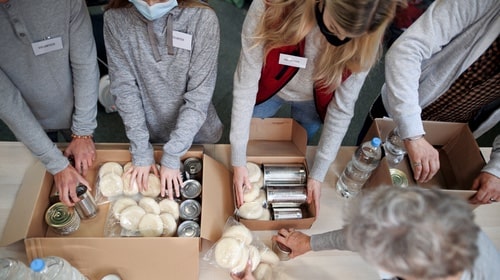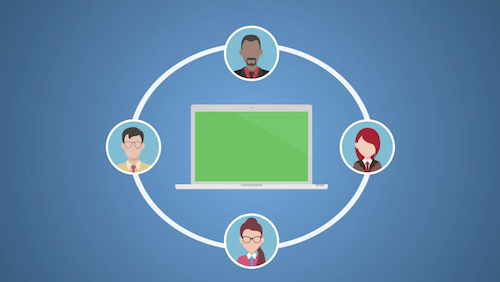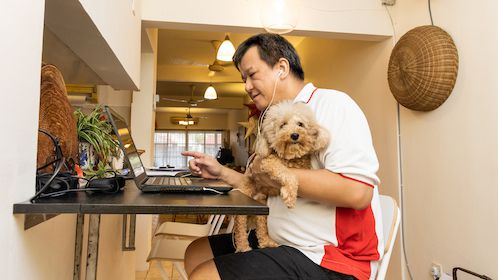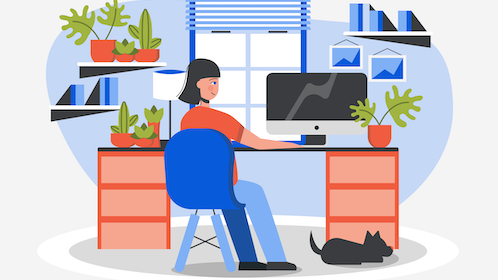The Process of Change Mapping
Authored by:
iClick2Learn Team
‘Click the video titles below to view them’
Transcripts are available under the videos.
Translate Text
– When things change, when we have changes to things like funding agreements, our service area, the people we’re servicing, our resources, or when other impacts like COVID happen, it means we need to rethink the way we’re delivering things. You might hear terms like service design, design thinking, co-design, and human-centered design, and think, what are they? They’re approaches and methods that you can use when you’re actually looking at how you need to change the way you do things. I’ll give you a brief summary of what each of these mean and then give you an example of how you might use them.
– Human centred design is about designing solutions with humans right at the front of every decision you make through every step of the process you undertake when you’re designing a service. Service design is about the planning and the organising the approach to making sure that this happens in order to improve the quality and the impact of your service. Now whilst it’s called service design, of course, you could reframe this and call it programme design or project design. Design thinking is really the process that helps guide your approach. And it’s about the thinking that goes into the design stage. It’s not just a process, it’s actually making sure you have the right people at the table, that you’ve got everybody thinking about solutions and opportunities that you have. Co-design is about bringing people together. It’s about thinking who is impacted, who you have an opportunity to connect within, whether it’s a service or a programme that you’re designing, but it’s about making sure that they have a voice at the table. It’s about making sure that whatever it is, is being designed in a way that thinks about them and thinks about what they need. I’ll give you an example. If you were designing, let’s just say that you’re an oldest service club and you were thinking about designing a youth programme, well, you wouldn’t do it without the voices of the youth at the table. That’s what co-design is about. About making sure that the very people you’re designing for have a voice, and they’ve been able to share the best way to approach whatever it is you’re doing to have the impact that you’re planning for.
– I’m going to share with you a process that was developed by IDEO. They’re probably, in my opinion anyway, one of the best design thinking practitioners in the world. They’ve also developed a human centred design course that you can do. And that takes you through, if this is of interest, it takes you through the deeper methodology. We’re not going to be talking about the deeper methodology in this video of course. There’s a lot of planning and a lot of study that you need to do in order to really understand the approach. But I am going to cover is just one of the tools within this methodology. And that’s a user journey and also empathy maps as well. So if we have a look at the IDEO process in its simplest form, it breaks down three stages. These three stages are the inspiration. So who are the people that you’re designing for? What is the design challenge? What is the challenge you’re faced with? But yet you’ve got a change to your geographical area that you’re supporting, or because of COVID, that’s presented a range of challenges that you need to deal with. The second stage is then going through, what is the opportunity that you have? So what are the insights? What are you learning from those? You know, we talked about co-design a moment ago. What are the insights that those clients or stakeholders are sharing with you in order to help you create a solution? So, for example with COVID, it might be that people are having volunteers and staff are having to work from home. Okay, well, what are they telling you about what that looks like for them? What do you need to know from the very people that are impacted? You might also, in that example, need to consider what your founders are saying and wanting as well as your management team and board. The third stage is in about implementation. Once you’ve gone through this planning stage, once you’ve thought about what your approach is, you’ve in essence done what I call a prototype and that is saying, “Okay, if we’re going to change the way we do things, this is what it looks like.” You’ve got feedback on that prototype. Now you’re actually putting it in place, you’re implementing it. And in this stage, it’s really important not to say, “Okay, that’s it. We’ve developed it, off you go.” It’s important to actually do those check-ins. Just because you’ve all come up with a great idea doesn’t necessarily mean it’s going to work in practise. So it is important to make sure that you’ve got those check-in phases as well. So I hope that’s helped you think through a very simplified way of looking at how you need to consider the change in your approach. Let’s look a little bit deeper into a tool called a user journey.
– A user journey is pretty much exactly what it says. Where you might not use the word user, you might use client or volunteer, if you’re remapping how your volunteers engage with your service or with the support that they offer. So when you think about a journey, it’s about mapping every step of the process that they take. Let’s look at a really simple example. Let’s just say that your club has monthly face-to-face meetings. Well, during COVID, that couldn’t happen when we had locked down, so what does that actually mean then for the people that are used to having a face-to-face interaction, but that needs to change. So we need to think through, okay, this is what they’ve been doing, so let’s map every step of the process. Now let’s consider those areas that need to change and what we will do to support that change. Now, that’s a very simplified user journey. With some of you, that will be enough, but with others who are delivering a service, you’re going to need to dig a bit deeper than that, and so for that, let’s look at another example.
– So this model that you’re seeing is a really great example. That’s going to help you dig a little bit deeper into service mapping and thinking about those things that you’ll need to support with the changes that are being proposed. For those of you who aren’t able to see it, let me give you a little bit of a description on what this is. There are four elements or rows, if you’d like. Each of those rows has a heading, at the top we have the end user. So for some of you, this might be clients, if you use that term. The second row is about how your service engages or interacts with those clients. The third row and the fourth row are really about the internal support. So the third row is about your internal staff. And this is about the work that the internal staff do in order to support those service interactions. And the fourth row is a supporting structure. Things like tools, processes, systems, technology that they need in order to do their job. So using an example, let’s just say that you are a helpline and somebody is phoning in. So you’ve got the client or the end user using the service interaction of a telephone to connect with your staff, who are then needing to access the software and the database in order to know what client they’re speaking with and who they normally deal with. So I hope that example gives you a really good understanding as to how those four layers are actually really critical. When you’re thinking about changing the way you do things and why it’s so important that we drill down that deep. One of the strategies for you is to actually map what you’re providing at the moment or what you’re mapping before the change, before the change needs to be implemented. So think about that through the four layers. Think about that from, okay, how do they even find us right through to that I’ve had the service and now it’s about maybe following up for a repeat visit. For services in particular, I know you need to map KPIs, et cetera. That’s on that very bottom line. That’s on that systems. We really need to think about the human journey, the user centred design, as it’s called human centred design and the user journey to make sure we’re mapping all of those elements. Then what you’ll do, is you’ll map what the current service interactions are. So, you’re going to map things that they used to receiving from you. So for example, they’re used to being able to access your phone and speak to somebody in an office and then quickly be transferred through, or they’re used to walking in the door and having a face-to-face consult. You’ll then map, well who delivers that service? And then the fourth row, which was the supports that that internal staff member needs in order to, for example, have that face-to-face consultation. So map what they’re used to having first, then think about the design challenge you have, think about that challenge of, for example, COVID has placed on barriers to accessing face to face consulting services. So depending on the state that you were in when you mapped it or that you’re currently in, you might be in lockdown at the moment, or even if we use an example of where your funding agreements changed and you’re now funded for less face-to-face consults, okay? So whatever design challenge it is that you’re having, this will really help you. You need to think about what it is and what parts of your service does that impact. Now, this could be across any of the lines. This could impact the number of people that are able to contact you via phone or the number of people that are able to contact and access the face-to-face consultation. Let’s just say, that’s to Christ, the face-to-face bits to Christ. Well, what does that actually mean? That means perhaps they need more support. Maybe they need more support on your website in terms of fact sheets or help sheets, maybe instead of face-to-face, it’s actually doing more phone consultations or video consultations, but then what does that mean for the people who are accessing it? If they’re tech savvy, doing a video call is probably okay, but if I haven’t done it, there are specific challenges they’re going to face. So is a video consultation really the best approach for them? These are all things that we need to think about. And again, it comes back to that human centred approach. If we think this is a great idea, if it’s actually not going to work for them, it creates a barrier for them accessing your services. And that’s not what we want. So again, map what’s happening, think about the challenges and then map what needs to change and then go back through and think about the people within this process. So you’ve got the users you’re trying to help, and you’ve also got your internal team or the staff or volunteers, and you need to think about how does this change for them? What’s the impact for them, personally. An empathy map is a really great tool that you can use to help think this through.
– So an empathy map covers four critical areas. And it’s about connecting with the people that are affected and impacted by the changes. It’s about asking them what they think about the proposed changes. You can do this internally by saying, “Well, what are they seeing? “What are they hearing? “What will they do? “And what are they feeling about that?” But obviously, if you’re thinking through it, it’s just your opinion. The best thing to do is, and this is where your co-design comes into play, is to actually go and consult with them and ask them about the proposed solution and what they feel about that, if they were able to take those actions. So if that doing part can actually happen, if they can get online. If not, what do they need as an alternative, or what do they need to support them to get online?
– Now, I thought we’d look through a very simple example. The example is, a person who is looking to volunteer for a helpline. Now this could be your community local neighbourhood centre, who has a helpline for local community members who are wondering where they go to for support. And they ring the neighbourhood centre and ask them, or it could be a more formalised structure, such as a lifeline helpline. Using the example we’re looking at, which I’m just going to describe for those who may not be able to see it and are listening to this. We’ve got four columns and five rows. Along the top column, the headings are the customer journey. And underneath that basically is the journey that they take. And so we’ve used an example, which was at service design. So we’ve got the front stage, which is what the user does. So in this case, this would be the volunteer. So the person who is looking to volunteer, I should say. So the prospective volunteer, we would call them. And the second stage is how they actually interact with us. And the third stage is how our team members, our staff or volunteers, and what they do in order to provide that support. And of course, we’ve got that fourth row, which is that supporting process such as technology. Now, I’m just going to use one example alone along the heading. We’ve got three different stages and it’s just a very simplified example of volunteer searches. And then they inquire about how they can help and then it goes to an induction process. Now I know for many of you, there’s a few more stages than these, but we’re just trying to keep it a little bit simple at this point. So I’m going to select the induction process. Let’s just say in the past that the prospective volunteer, once they’re approved, et cetera, they go through a face-to-face induction, but that can’t happen anymore. We need to change the why we do this because of, if for example for COVID, because face-to-face isn’t possible. Or we used to have a big workshop and we bring in all of our volunteers, 50 prospective volunteers, for example, every quarter, but now we can’t bring in that many people. So what we need to look at is, how do we do that differently? So that’s an example of kind of mapping what you’ve been doing and then saying, “Well, hang on, what needs to change as a result?” And of course, because that face-to-face element changes, then so does every other area within that maps. So does the support they receive from your team members and also, you know, the supporting processes need to change. If you’re now doing, for example, online inductions instead of face-to-face, well, what does that look like? How does that change the process? So I hope this example talking through it, and if you’re able to see the example on the screen, has helped you to think through what it might look like if you’re using this approach.
– I think it’s always helpful to look at some examples of what other peers are doing, and INCOSE members have shared some of those that I want to share with you today. Let’s look at a couple of them. So this example is Gig Buddies Sydney. Gig Buddies is an initiative of a disability service that’s a registered non-profit committed to promoting the rights of people with learning disabilities to make sure that they are living the lifestyle of their choosing, so this is a project that’s being developed and it really relied heavily on face-to-face contact. Gig Buddies certainly is about music, so of course they also needed to access venues. Now, that all changed during COVID, so what did they do instead? They recognised that it was still really important to provide that social interaction that they were so used to having pre-COVID, so they developed an Online Socials, they called it, so this had things such as virtual bingo, charades, themed quizzes, they even had karaoke, and a number of other games and the staff facilitated Facebook chats as well. Now, probably not surprising that they liked it so much that they said actually, when things get back to, you know, the new normal, when we’re able to meet face-to-face, we really liked that online interaction so much we’d like it to continue. The other example is to Toukley Neighbourhood Centre. Toukley Neighbourhood Centre provide food relief. Most of their volunteers are actually elderly, and they were in the high-risk area, and so what that meant, of course, is to make sure that volunteers were safe and protected, that they couldn’t continue the service and they actually closed it down. But then there were still 500 families that needed support, so what they did is they innovated. They actually went to an online click & collect, and it wouldn’t surprise me if, actually, the online click and connect is really easy and accessible for a number of people they support that they’ll probably, when things go back to the new normal, they’ll probably still continue to offer that online service. And I think that’s an important thing. When things change and when we’re challenged, yes, it’s frustrating, and it’s really, you know, to think through how are we going to do this, it actually gives us an opportunity. It does give us an opportunity to innovate, to deliver a service that perhaps is more accessible, that maybe helps more people than we’d originally considered.
– So we’ve just touched really quickly on four methods. Design thinking, human centred design, service design, and co-design. And we’ve covered two simple tools that you can use, which was the user journey and the empathy map. Now obviously, there’s so much more value in those four methodologies that I expressed, but in times of crisis, you just need to put something in place quickly. And so using those two tools will actually help you start to make an effective change. You’ll have time then to go back and look at the methods and ask, what are we missing? What should we also consider in the process?
- Tags | Change mapping, Covid, Operational Systems




